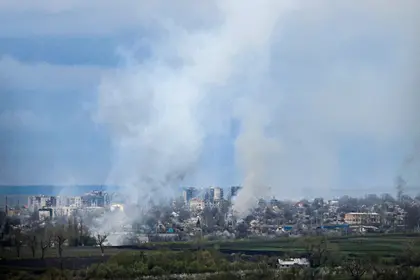What’s likely to have happened?
On May 10, a day-time assault was undertaken by the 3rd Separate Assault Brigade, an Azov movement unit within the Armed Forces of Ukraine (AFU), on the outskirts of Bakhmut.
A senior spokesperson for Azov, Andriy Biletsky, and the leader of PMC Wagner Group, Yevgeny Prigozhin, issued separate video statements essentially confirming that the assault had been successful. Having said that, Prigozhin may have used his statement to both leverage the Kremlin for more operational support and for more command control over the Bakhmut battlefield.
JOIN US ON TELEGRAM
Follow our coverage of the war on the @Kyivpost_official.
Ukrainian sources further claimed that their forces had destroyed the 6th and 8th companies of the 72nd Motorized Rifle Brigade of the Russian 3rd Army Corps. The 3rd Army Corps is part of the regular Russian military rather than the private Wagner militia, which has led much of the fighting in Bakhmut. Most recently, Wagner is reportedly struggling to bring in reinforcements as their losses mount and their prisoner recruitment initiative has ended.
Ukrainian sources also claimed yesterday that their forces had advanced 2.6 kilometers along a 3-kilometer front line in the area.
Following a visit to the battleground yesterday, Colonel-General Oleksandr Syrsky, the highest ranking infantry commander of the AFU, said in Telegram that “we carried out effective counterattacks… The enemy… could not withstand the onslaught of Ukrainian defenders and retreated to a distance of up to two kilometers” at different points of the front.

Trump Makes 90 Day Foreign Aid Freeze – Ukraine Military Support Supposedly Untouched
The respected and independent Institute for the Study of War (ISW) was somewhat more circumspect in its daily report for May 11. It confirmed that geolocated footage from May 9 and May 10 “indicates that Ukrainian forces likely conducted successful limited counterattacks north of Khromove (immediately west of Bakhmut) and northwest of Bila Hora (14 kilometers southwest of Bakhmut) and made marginal advances in these areas.”
However, ISW noted that it “has not observed visual confirmation of these reported wider Ukrainian advances,” i.e., of 2.6 kilometers along a 3-kilometer frontline.
Is the successful assault significant?
While a Russian defeat or withdrawal at Bakhmut would be very significant, the successful assault is only one part of a larger battle. There are different views about the momentum or direction of the battle, but its intensity is clear.
Yesterday, there were 28 combat engagements and 524 Russian strikes recorded in the Bakhmut zone, according to Serhiy Cherevaty, the AFU’s official spokesman for eastern operations.
He also told Ukraine’s United News telethon that “Ukrainian troops had decimated 203 invaders, wounded 216 more, and captured 5.”
When asked about statements by Wagner’s leader Yevgeny Prigozhin about a possible tactical withdrawal from Bakhmut and ammo shortages, Cherevaty noted:
“A military disaster is behind these statements. Because when American sources estimate [Russian] losses in [Bakhmut] at 100,000 casualties, 20,000 killed, it is a very conservative estimate. If they lose at least 100 soldiers killed per day and have no source of replenishment, as they used to get from Russian prisons, it is clear that their inglorious story may end there… Now, [Prigozhin] has to spin his failure to achieve what he promised.”
Cherevaty continued that Wagner fighters are still the main Russian force at Bakhmut, but that the Russian military is increasingly forced to use units of the regular army due to heavy losses.
One of those units is the 72nd Separate Motorized Rifle Brigade, which was apparently on the losing side of the successful Ukrainian assault. According to ISW, in September 2022, as part of the 3rd Army Corps, it deployed to Kharkiv Oblast and was largely destroyed by the Ukrainian counteroffensive there. ISW further noted that the surviving elements of the 72nd Brigade may have then been redeployed to Mykolaiv Oblast where they once again suffered losses during Ukraine’s southern counteroffensive in October 2022.
ISW stated that “it is highly likely that whatever elements of the 72nd Brigade that deployed to the Bakhmut area more recently are not operating at anywhere near full strength.”
It also assessed that the Russian military command’s “apparent commitment of elements of a formation that has suffered two successive defeats to the Bakhmut axis alongside already attritted Wagner elements” would be likely to “offer Ukrainian forces opportunities to exploit with limited counterattacks.”
Ultimately, ISW determined: “Issues with the ad hoc commitment of various depleted force groupings to the Bakhmut axis, alongside apparent command and control failures, are likely preventing Russian forces in the area from conducting sound defensive operations.”
You can also highlight the text and press Ctrl + Enter










